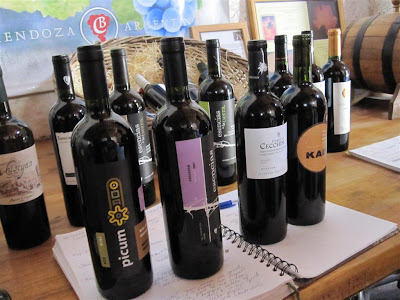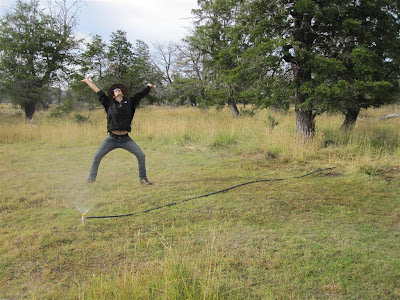Fish! At long last..
Best way to cure a long bus ride! (10:30 am...)
The next morning we ate a quick hostel breakfast and then hopped on a bus to the small city of Maipu. Unfortunately, the city wasn’t very accommodating to tourists without a vehilcle, so we ended up wandering on dirty roads hoping to find a vineyard or a cab. Eureka! A cab showed up, who must have been Argentina’s slowest cab driver, stopping at every intersection rather than burning rubber through, stopping to ask for directions even though we knew the way, and double guessing every turn. Argh! Fortunately we made it to the famed Cecchin organic family vineyard before the meter ran up to anything too ridiculous.
The fertile vineyard resides in the arid valley of Mendoza at the base of the impressive cordillera de los Andes around 75 hectacres. We were fortunate to get a personal tour right away through the beautiful vineyard. First, we visited the vines themselves, where we saw malbec and cabernet sauvignon vines, and learned how to differentiate the two. We also learned about Mendoza’s very strict irrigation laws – only x-amount of water per hectare (but it was barely enough to keep the vines alive – which actually worked out in their ‘favor’ for the taste of the grape). Interestingly this was one of the only vineyards in the area that grows organically: no fertilizers, plowing weeds under with a horse-drawn plow, and no pesticides. The vineyard looked very productive and healthy, but we found it very odd that they watered with furrows and trenches rather than drip irrigation. Answer: drip hose technology is very expensive in Argentina, and furrows are ‘easier.’
left = malbec , right = cabernet
On the way back from the vines we got to try some very rare grapes hanging from a trellis that were AMAZINGLY sweet!!
We then walked into the processing room that had a relatively small processing facility for separating the seeds from the fruit and then 2 hydraulic presses for the crush. The wine is then fermented in cement cisterns (they claimed they used the cement for a certain ‘taste’, but we were quite sure that big stainless steel tanks may have been too expensive…).
After the short tour we went to the tasting room and tried 2 of their wines. First we had a really great Muscatel variety which they proudly claim comes from Africa, which reminded us of a much sweeter almost dessert like version of the famed Torrontes. It was a first time ever trying this ancient varietal and we plan to try it again in the future (maybe with a bit of vanilla ice cream!) Second, we tasted their 2007 Melbec, which was good, but didn’t have the same lasting impression as the Muscatel. All in all, it was a great organic bodega experience and possibly a future imported bottle will be fun to have with dinner once we are back in the states.
To be exported to US or Europe
After wine tasting, we walked a kilometer down the road to an olive oil processing facility. It was the oldest facility in the area and was started by Italian immigrants in 1920. The olives are harvested around April/May (follows right after the wine grape harvest!), and then go through a fascinating ‘cold-press’ process. They explained why cold-press is so difficult, and why it tastes sooo much better. This process begins when the olives are crushed by two large rolling stones, which separated the seeds, and then the leftover olive mash is laid out in metal wire disks to be stacked and crushed in a hydraulic press. Olives are about 20% oil and over 50% water. The ‘cold-press’ method can only extract about 15% of the oil. This is less efficient, but considered the “pure” method because the oil is extracted without the use of chemicals. The pressed out oil is then put in settling tanks for 24 hours to allow the liquids to separate by the process of decantation then the oil is ready to be bottled. Quite a process! Interestingly, the mash that’s been pressed, but still has some oil left in it goes to another facility to be separated the conventional chemical method. We also learned the differences between “extra virgin olive oil”, “virgin olive oil” and “olive oil”, which has to do with the fatty acids called OMEGA’s. Before we left, KK stocked up on nice lotions and creams, and Ivan grabbed some delicious olive oil.
Almost ready to harvest!
Stone crush
Settling tanks
Samples!!
After a day of walking and hot sun, we were both very excited for our fancy dinner at Argentina’s best restaurant: 1884 by Frances Malmann. Back in September Sue, the main manager at Ever-Bloom, generously gave us some ‘fun money,’ with explicit instructions that it be spent on something really memorable and enjoyable. We decided this dinner would be the best way to do it!
When we arrived, we grabbed some drinks from the beautiful bar and sat out on the nice patio – a glass of 2006 cabernet sauvignon from Bodega Escorihuela for Kristin, and a nice artisan beer for Ivan. In true Argentine fashion they had a giant parilla right on the patio for cooking up the fantastic cuts of meat!
The host escorted us inside and we sat at the nicest table/atmosphere that we have yet seen in our travels, and the absolute best service to boot! Ivan started with a sizzling prawn dish, and Kristin had a baked pumpkin arugula salad with pecorino cheese and walnuts. Yummm! For wine, we decided on a really fancy Malbec from Bodgea Urraca (this was quite a difficult part of the evening because there were about 400 different wines to choose from...). By far the best Malbec we’ve had in Argentina! Also, they had fantastic selection of homemade bread (not just plan white bread!!) that we could dip in local artisan olive oil and balsamic.
Fancy! (but divide by 4)
For our main courses, Kristin had salmon with tomato and watercress, and Ivan had the best ‘ojo de bife’ (rib-eye) steak in the world. The food was the best we’ve had since we were last spoiled in Nevada City and Santa Barbara! ¡Gracias Sue!
So goood!
The following morning we were very excited for our wine tour up into the Andes, but, in true Argentine fashion we received word (5 min after it was supposed to start) that it was cancelled… So, we decided to take it easy that day and walked the city, enjoyed a beautiful picnic in the large park (reminded us of the Golden Gate Park) and did some silly tourist shopping. Later that evening we decided to go out for a nice meal and order a bottle of wine since it was our last night in Argentina. For our meal that night we went out to a really great café and shared a nice bottle of Torrontes with some bread. It was a great way to enjoy a bottle of wine for 2 hours, people watch, and soak in the Mendoza culture.
The following morning we hopped on the bus for Valparaiso, Chile. Adios Argentina!












































































